We’d like to remind Forumites to please avoid political debate on the Forum.
This is to keep it a safe and useful space for MoneySaving discussions. Threads that are – or become – political in nature may be removed in line with the Forum’s rules. Thank you for your understanding.
Sorting issues with damp in victorian terraced house

Hi all
I’m looking for some help and opinions on solving some damp related issues please. Due to everything going on with covid at the moment I have been unable to get a surveyor to come around and take a look properly. If some of the corrective actions are relatively straight forward and something I can do myself, I would rather get it sorted sooner rather than wait around indefinitely.
The property is a two-storey three bedroom terraced house in Cardiff.
The damp is mainly appearing in two places. In the bay window (and either side of the window) on the front elevation of the building, as well as on a small section of an external facing wall (in the same room) towards the back of the property where the side return passage is.
I suspect there are probably number of different issues rather than just one, with factors likely to include a combination of historic construction issues combined with bodge jobs by the previous owner. To make it easier to explain the attached PDF provides an overview and images - any help and support that can be offered would be greatly appreciated.
One possibility would be to get a liquid DPC injected in the affected areas, but there appears to be differing schools of thought as to the suitability of that option. Also, even with such a treatment I'm not sure what I can do to help dry out and contain the issues that currently present.
Thanks
Comments
-
Oh dear. It looks like a previous owner has been buggering about with that house. Gypsum plaster internally, (probably) cement render externally - Neither are good for a Victorian property which would have had lime mortar & plaster originally.Those timbers appear to be resting on a sleeper wall without any DPC between the two - That is one source of damp causing the joists to rot. Lack of ventilation isn't helping.Reducing the external ground levels will help to some degree, as would hacking of the gypsum plaster & cement render (all of it, not just a thin strip at the bottom). Certainly wouldn't waste time with chemical injection - I suspect that it has been done before, hence the gypsum & cement slapped on everywhere. The area around the corroded steel back box appears to be a cement render consistent with previous damp proof "treatments" - Clearly it hasn't worked, so why spend another chunk of money on the same treatments...On the subject of back boxes - There is major corrosion on the visible copper wires. It looks like the earth wire is broken - Please get the electrics checked by a qualified electrician and consider a full rewire.Any language construct that forces such insanity in this case should be abandoned without regrets. –
Erik Aronesty, 2014
Treasure the moments that you have. Savour them for as long as you can for they will never come back again.2 -
I should have mentioned that this has now been isolated and removed completely. I had to cut the earth cable when removing it, as there was barely any flex and the screw was corroded.FreeBear said:On the subject of back boxes - There is major corrosion on the visible copper wires. It looks like the earth wire is broken - Please get the electrics checked by a qualified electrician and consider a full rewire.
The ends of some of the timbers have been dipped/painted in what looks like bitumen, which I presume would serve as a DPC. It's difficult to tell whether the joist that was rotting ever had any bitumen on it, or whether this has just vanished as the wood has deteriorated. I guess the other issue is I have no idea whether that bitumen would have been applied during original construction or whether it has been some misguided attempted at a repair sometime in more recent years.FreeBear said:Those timbers appear to be resting on a sleeper wall without any DPC between the two - That is one source of damp causing the joists to rot. Lack of ventilation isn't helping.
When you say timbers resting on the sleeper wall - are you referring to the beam itself, or the inch-thick length of timber that the beams are resting on? (or both).
A naive question maybe, but that length of timber that is between the sleeper wall and the floor beams appears to be placed in a bedding of lime mortar, with the sleeper walls themselves being constructed out of natural stones bound with the same lime mortar. Would I be correct in thinking that the breathability of these materials should be sufficient in normal circumstances to prevent any wood that is in direct contact from rotting, or would a DPC of some sort always be required? In either case I guess it will be relatively easy to either slip in a bit of DPC, as well as potentially replacing the initial timber.
I've scratched a bit further back and it appears that the plaster around bay window area has definitely been patched. It looks like there is newer pink skim going up to the bottom of the sill as well as up to about 1.2 meters on the left hand side of the bay, cutting back down at a 45 degree angle and wrapping a little bit around the area with the rotting timber. The remaining plaster I suspect is the original lime, however both has been skimmed over with what looks like gypsum. This kind of patching makes me think it relates to a previous (and failed) damp proof treatment, however I can't see any indications in the bricks either side to suggest any kind of liquid dpm injection.FreeBear said:Reducing the external ground levels will help to some degree, as would hacking of the gypsum plaster & cement render (all of it, not just a thin strip at the bottom). Certainly wouldn't waste time with chemical injection - I suspect that it has been done before, hence the gypsum & cement slapped on everywhere. The area around the corroded steel back box appears to be a cement render consistent with previous damp proof "treatments" - Clearly it hasn't worked, so why spend another chunk of money on the same treatments...
From what I understand, this region was flooded heavily in the 1970s, and the water may have just reached the boundary of the property. It is possible they had to so some work at that point to address the bay window.
In the interests of keeping costs down as well as minimising destruction while house-bound, would hacking back just the newer plaster and then patching it with lime-based be feasible, or does the whole lot around the bay window need to be removed? I'm cautious that the yellowing beading appears to be on top of lime based plaster, but I guess the moisture could be wicking up the skim anyway.
If going back to brick anyway, having gone this far is there any value as a precaution in getting a liquid DPM installed in the effected areas and then continuing to reinstate with a lime based plaster to maintain breathability?0 -
The joists rest on a strip of timber that is placed along the top of the sleeper wall - I would expect to see either slate, bitumen, or some other form of DPC between this length of timber & the sleeper wall. It may be that there is a DPC a little further down the wall, but can't tell from your images (and I'm not opening up the PDF again as it takes way too long to render). If the joists are original (which they probably are), building practices at the time would have seen the ends of the joists dipped in bitumen, so nothing unusual there. If you are replacing them, just ensure there is an air gap between any wall & wood and slip a bit of (plastic) DPC under them.As for chipping plaster off - You won't get just the skim coat of gypsum off. The lime plaster will most likely have blown (sounds hollow when tapped), and will fall off the bricks in chunks. Might as well go right back to brick, get rid of that waterproof render, and replaster in lime as it would have been done originally.Installing "liquid DPM" is a waste of time and money - It does not work. The usual practice when injecting a chemical "DPM" is to slap waterproof render/plaster on the walls up to a height of ~1.2m. The installers will claim that this has cured any damp... All it has done is seal the wall and stopped the ingress of damp in the short term. If you want other worthless and expensive "cures", have a look at this page - https://www.heritage-house.org/damp-and-condensation/all-about-the-pca/the-damp-con-collection.html
Any language construct that forces such insanity in this case should be abandoned without regrets. –
Erik Aronesty, 2014
Treasure the moments that you have. Savour them for as long as you can for they will never come back again.1 -
I’m a big believer in fixing the cause before trying remedies. They often don’t work. Is there anything you can see that would cause the damp? As far as I know rising damp is actually fairly rare. As Freebear says the render and gypsum will just compound the problems. Old houses need to breathe. Are the air bricks still in place?We own a Victorian end of terrace in the Vale, so not far from you, and we’ve had terrible issues with damp but each one had a cause that was not damp itself. Leaking chimney, dodgy gutter, blocked air brick, ground level too high etc. We are currently dealing the the bedroom overlooking the side return where the window is rotten and previous owners have covered up the issue rather than fix. Last night we removed the wallpaper ready to start the drying process, uncovered a mess of gypsum plaster and filler, and when we tapped it all the lime plaster has fallen off right back to stone. It’s a state. But it’s soaking wet even though it’s had months to dry out, because the gypsum and filler have trapped the water in the wall!1
-
Thanks, really appreciate your view on this. Cleaned back a bit of debris and rotten wood away for a better look earlier.FreeBear said:The joists rest on a strip of timber that is placed along the top of the sleeper wall - I would expect to see either slate, bitumen, or some other form of DPC between this length of timber & the sleeper wall. It may be that there is a DPC a little further down the wall, but can't tell from your images (and I'm not opening up the PDF again as it takes way too long to render). If the joists are original (which they probably are), building practices at the time would have seen the ends of the joists dipped in bitumen, so nothing unusual there. If you are replacing them, just ensure there is an air gap between any wall & wood and slip a bit of (plastic) DPC under them.
As you can see it is evident that the batten in that area has had it, so will be replacing that. I can't see a damp proof course anywhere on the sleeper wall, but I guess there could be something buried in the middle of it somewhere, as have found bits of slate in other places. There was an air gap between the beam and the wall on either side, but it is possible that some debris had built up over time and bridged with the brickwork. As there was no bitumen on that beam, and it is also a bit thinner that the others, I have a suspicion the previous owner may have changed it out at some point.
When replacing the batten, I'll probably lap it in a plastic DPC as you mentioned, and as a precaution will do the same to the beams while there.
On the second image you can see a bit of black slither and a hollow space below the brick - this looks like a bitumen DPC to me, which I presume has been there from the start, but I believe it is below the current ground level (not that I think that level has ever changed if I'm honest) - a small french drain might be just the ticket there.
The first foot or so of the damaged beam hasn't got much life left in it and needs to be sorted, but the rest visually appears to be ok. Would dowsing it in some cuprinol to stop it deteriorating further and then sistering it with a new beam be sufficient? Taking more of the floor up to change the whole thing would be a bit problematic, but if has to be done....
In regards to the damp in this corner, this has definitely been an issue in need of sorting out but I think I am yet to find the actual route cause of the problem.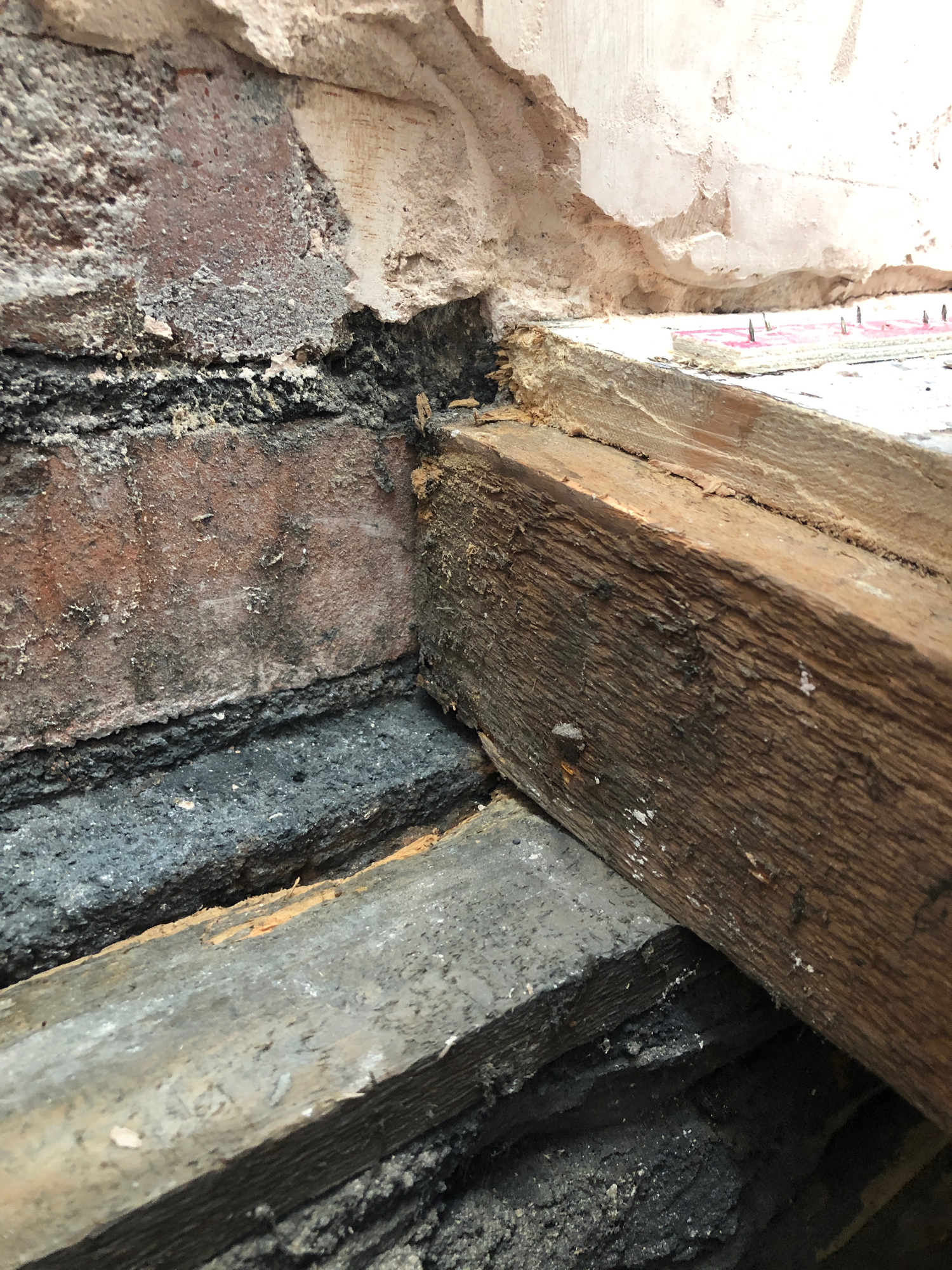
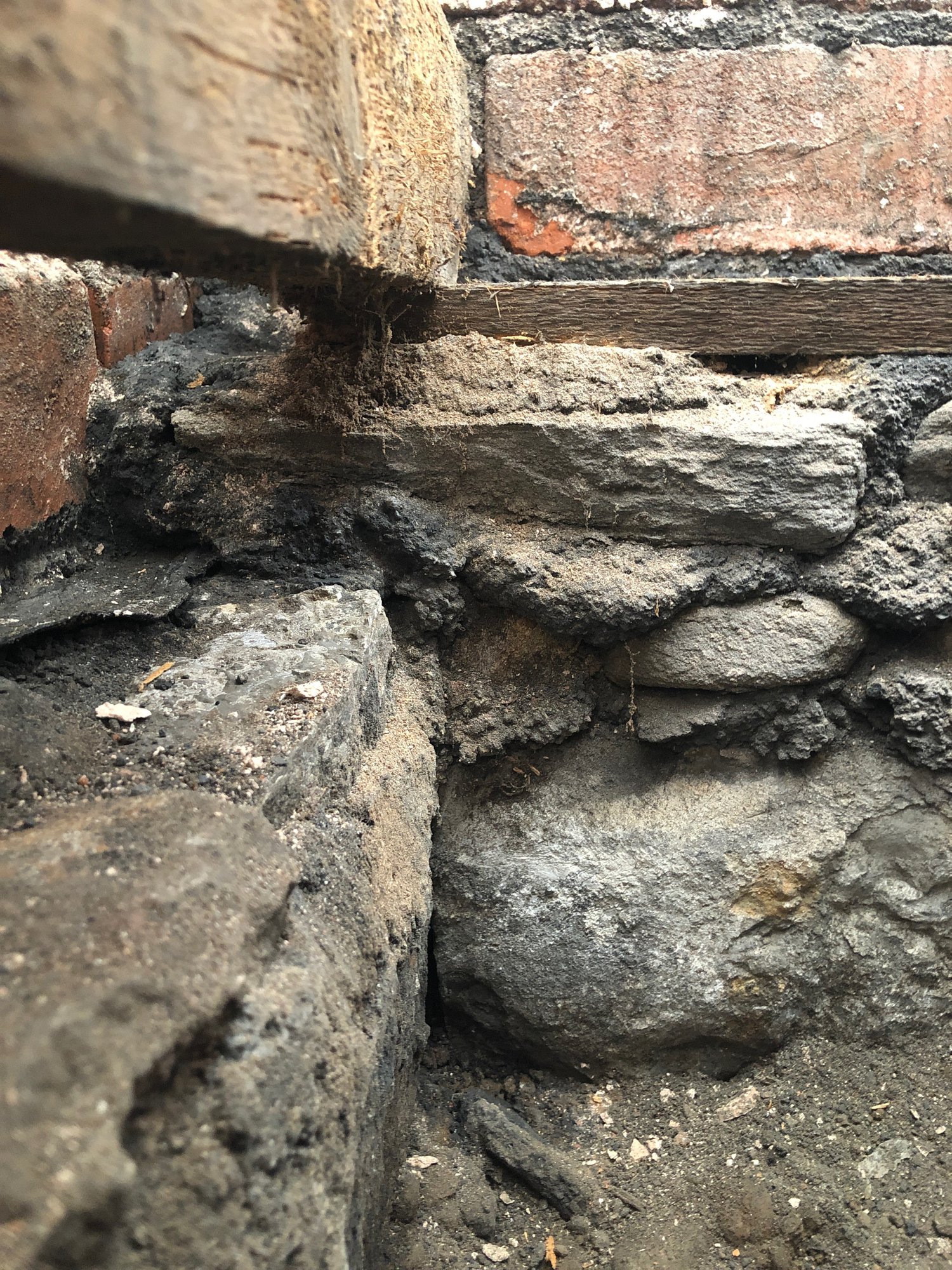
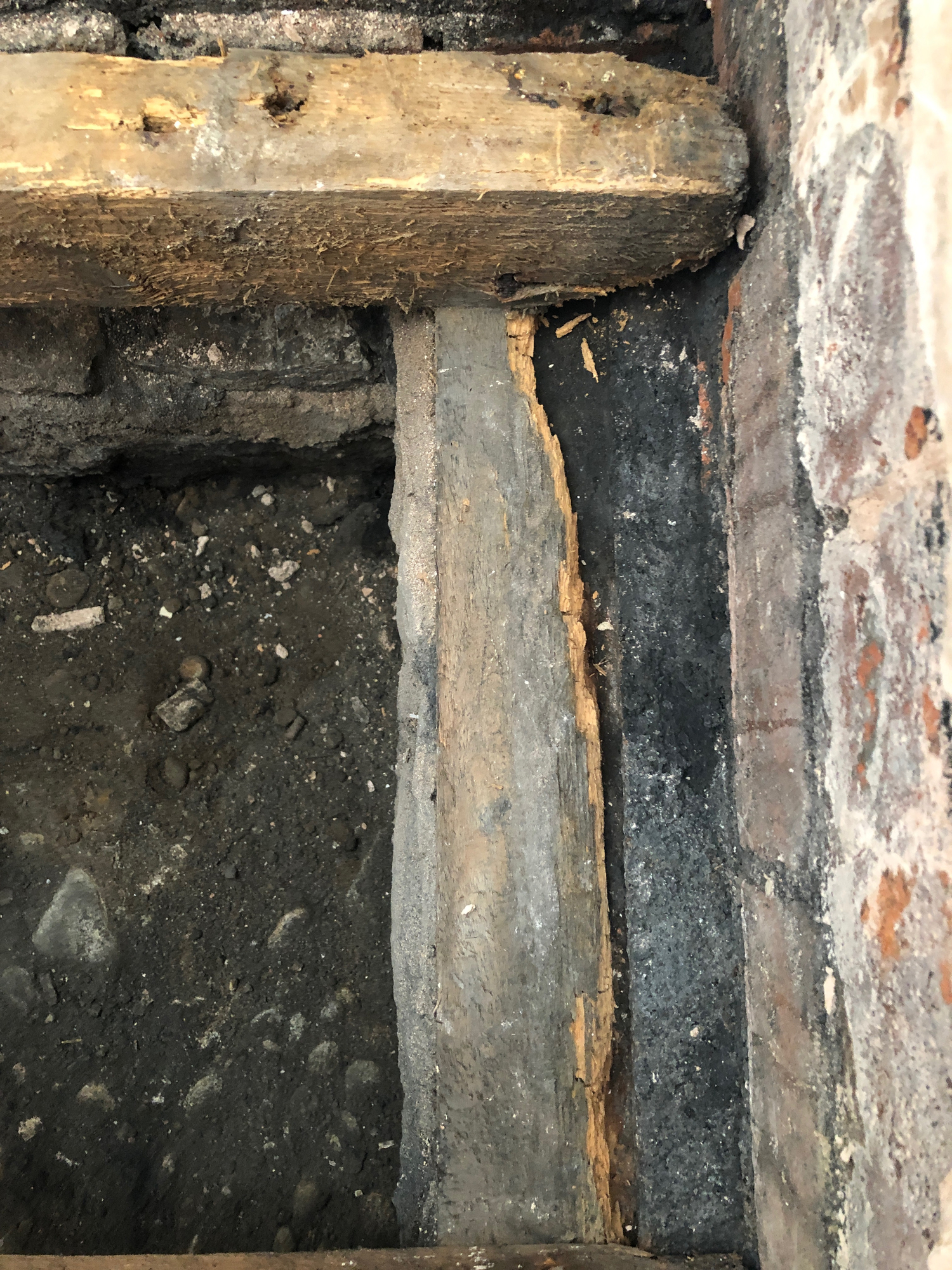
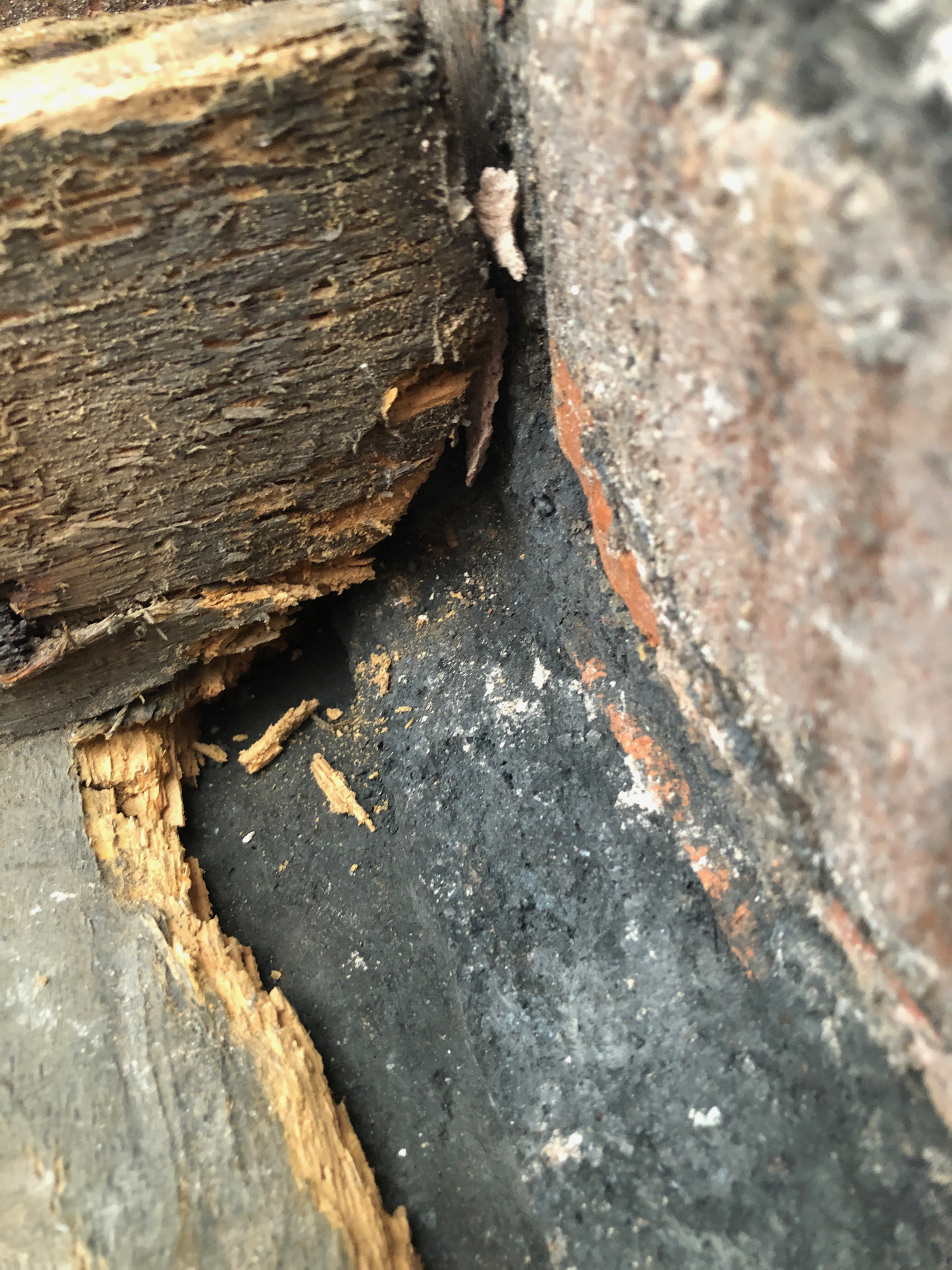
0 -
Totally agree with you regarding fixing the root cause, and as I intend on being in the property long term I would prefer to getting it sorted now rather than have it in the back of my mind! There is an issue with a missing air vent, which I am reinstating, but I suspect that is an additional issue rather than the root cause of the issue here. From speaking to my neighbour today, he recalls the previous occupant having issues in this corner some years ago, with metal beadings in render rusting and being very obvious through the wallpaper, as happened to the socket. The main cold water feed for the house used to run all the way up just on the corner of this internal wall. That has since been removed, but as it was a lead pipe there is a possibility that it has wept and saturated that wall over an extended time period, and given the external cement render and cement tanking internally, I guess it would be a similar case to what you have of water being trapped in the wall. Externally, the clay soil stack is close and disappears underneath (or at least near) the problematic wall. I'm hoping the issue doesn't stem from this as it looks like it would be a nightmare and hellish expensive to get sorted out. I guess its worth eliminating other possibilities first.SameOldRoundabout said:I’m a big believer in fixing the cause before trying remedies. They often don’t work. Is there anything you can see that would cause the damp? As far as I know rising damp is actually fairly rare..... But it’s soaking wet even though it’s had months to dry out, because the gypsum and filler have trapped the water in the wall!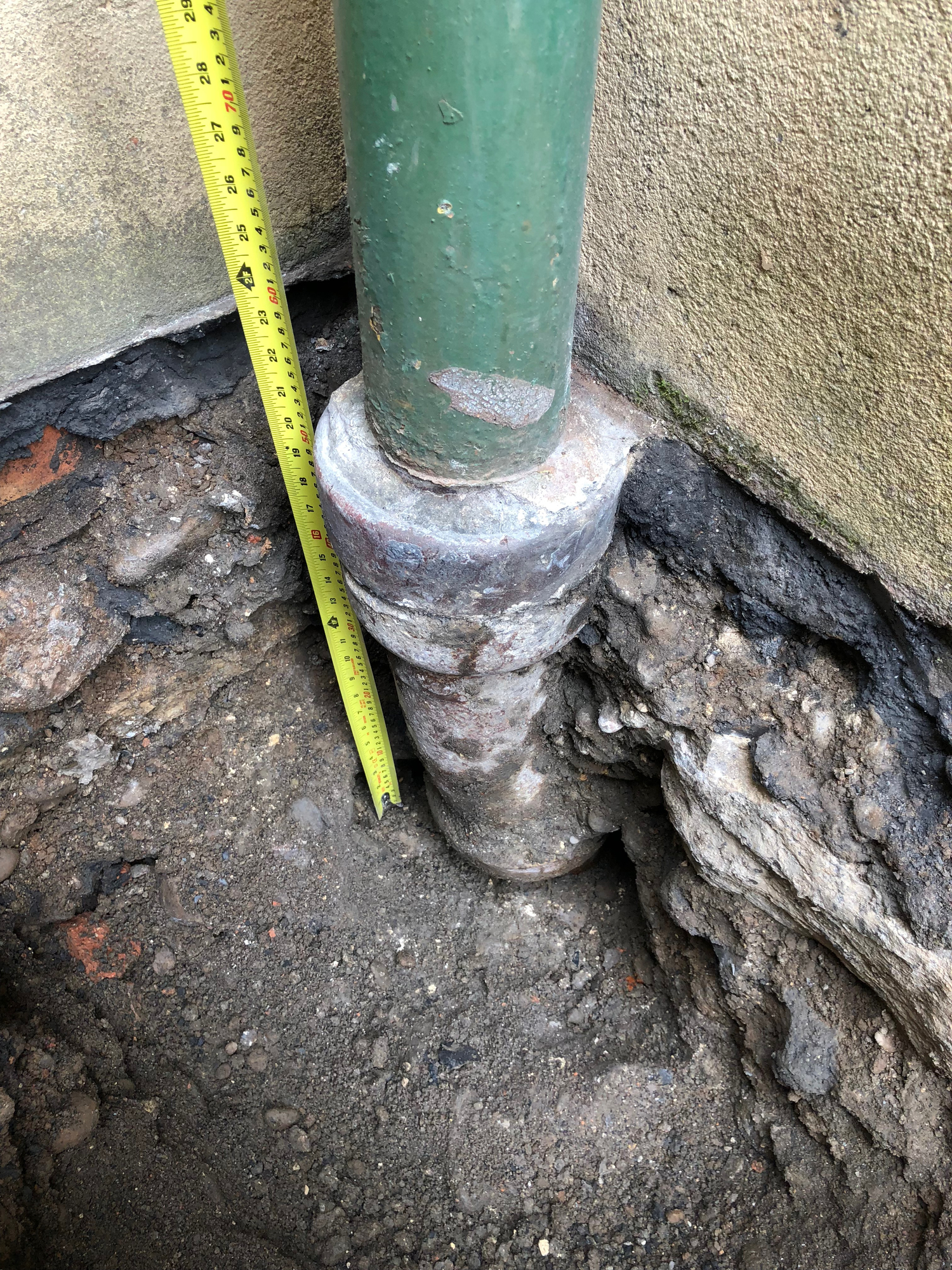
My thoughts at the moment are to hack the tanking back to bare brick internally (as well as possibly for the first 1.5 meters externally) to allow the brickwork to dry, and digging a small french drain to address and issues with the ground level. I may have to leave it like this for a month or two anyway until I can any lime plastering sorted, and I presume it would need this long to dry anyway.FreeBear said:Might as well go right back to brick, get rid of that waterproof render, and replaster in lime as it would have been done originally.Installing "liquid DPM" is a waste of time and money - It does not work. The usual practice when injecting a chemical "DPM" is to slap waterproof render/plaster on the walls up to a height of ~1.2m. The installers will claim that this has cured any damp... All it has done is seal the wall and stopped the ingress of damp in the short term.
I have a dehumidifier - is it worth having that on the go next to the wall as well, or leave it to air dry? I guess the other issue, any tips on monitoring the wall as it dries out to assess if the issue has been resolved. I know its obvious if a wall is saturated or not, but I guess assessing moisture levels once that has dried off could be a little more tricky.0
Confirm your email address to Create Threads and Reply

Categories
- All Categories
- 352.9K Banking & Borrowing
- 253.9K Reduce Debt & Boost Income
- 454.7K Spending & Discounts
- 246K Work, Benefits & Business
- 602K Mortgages, Homes & Bills
- 177.8K Life & Family
- 259.9K Travel & Transport
- 1.5M Hobbies & Leisure
- 16K Discuss & Feedback
- 37.7K Read-Only Boards


